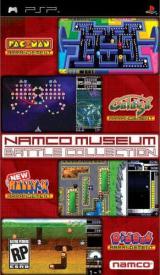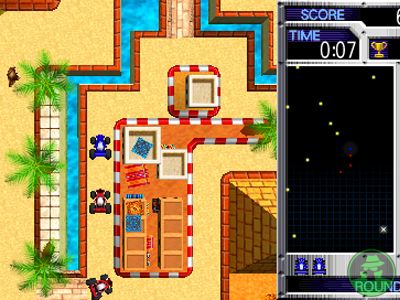There are generally borders around each of these classic games to better preserve the arcade's aspect ratio. If you're one of those people who hate letterboxing on your movies, you can change the screen display so that the image fills the screen. It's ugly, but it's still a nice option for people who are into that sort of thing. Slightly more interesting is the ability to rotate the screen so that you play vertically. This gives you a larger display, but it can be awkward trying to control the action when the d-pad is located below the screen and the buttons are above it. The game does give you plenty of options to customize your control, however. You can, for example, have the screen positioned vertically in Galaga, use the d-pad for movement, and the analog stick to shoot. It's not an ideal control scheme, but kudos to Namco for having plenty of customization.
Changing and Rearranging
The remaining four titles are arranged versions of Pac-Man, Galaga, New Rally-X, and Dig Dug that feature improved graphics and sound, new levels, and power-ups. For those of you who have played the PS2, Xbox, or GameCube versions of Namco Museum, note that the arrangements of Pac-Man, Galaga, and Dig Dug are different than the ones featured on those versions. The console collection contained ports of the arcade arrangements -- Battle Collection features arrangements created especially for PSP. On the whole, the arrangements are all fun improvements on the original games' formulas. I do, however, prefer the arcade Pac-Man Arrangement to the PSP version, and I'm not a fan of the clunky rendered Dig Dug that's featured in this arrangement (the Mr. Driller-ized version of ol' Diggy looks much better ).
When it comes to multiplayer, Battle Collection has some interesting options. The arrangements all have either a co-op or vs. mode, with support for up to four players depending on the game. Pac-Man Arrangement features both modes, and is the most fun of the group, but all of them make for some good time killers. The classic games are multiplayer, too, but only via the old "hand the system to the other guy when you die" method of wireless gaming.
Share and Share Alike
Battle Collection is also notable for being the first game in the U.S. that supports game sharing, which allows you to transfer games to another PSP. Unfortunately, it's fairly worthless in this game. You can share all 17 of the classic games, but all you send over is one stage. Clearing a stage in Galaga or Dig Dug doesn't take all that long, so your friend will barely have a change to get into the game before being yanked out of it.
It's also slightly disappointing that there's no actual "museum" content to be found here. I'm not expecting interviews or anything like that, but a few art galleries wouldn't have hurt. Still, with 21 games to choose from (and most of them bona fide classics), one can hardly complain too much. It may sound odd, but one of the best titles available for PSP is a collection of 20 to 25-year-old games. Hardcore retro fans will love how great the games look, and the casual player will enjoy playing Ms. Pac-Man for a few minutes on the bus. I just feel bad for the Japanese fans who will undoubtedly have to purchase Namco Museum Final U.S. Mix Plus Alpha at some point in the near future.






